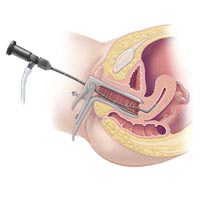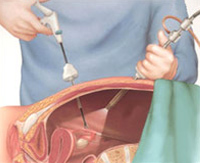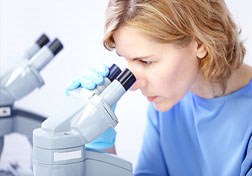Laparoscopic operations are often used in gynecology in the treatment of various uterine pipe diseases, ovaries and uterine. The advantage of this operation is a low trauma and rapid recovery. In the treatment of what diseases this method is used?
Content
 Sterilization is the very first operation that performed laparoscopically. With this operation, the uterine pipes intersect or are overtaken by bipolar current, and then intersect. This type of contraception is recognized as the most reliable, but, unfortunately, irreversible, therefore, it is carried out by patients over 35 years old, already having at least 2 children.
Sterilization is the very first operation that performed laparoscopically. With this operation, the uterine pipes intersect or are overtaken by bipolar current, and then intersect. This type of contraception is recognized as the most reliable, but, unfortunately, irreversible, therefore, it is carried out by patients over 35 years old, already having at least 2 children.
Ectopic Pregnancy - 98% This Pipe Pregnancy. This means that the Fetal Egg is located in the Sailing Pipe. Ectopic pregnancy refers to states threatening in intra-abdominal bleeding, so it is necessarily operated, and urgently. In operations about pipe pregnancy, 2 main techniques are applied - when the first pipe is cutting along, the fruit egg is removed from the lumen of the pipe, the pipe is left on the spot. With a different version, the pipe is removed immediately, regardless of the timing of the detected tube pregnancy, believing that the pipe is already amazed and the next pregnancy will again be ectoped.
Spikes around the uterine pipes (peritabar spikes) - coagulate with electric forceps (bipolar coalulator), and then dissected with scissors. Such spikes are after transferring operations (after expensive - in 90 - 95% of cases, after laparoscopy - very rarely), after sexually transmitted infections, in the main chlamydia. Safety process - the most frequent factor of infertility and is called a pipe and peritoneal factor in infertility.
Violations of the patency of uterine pipes - an important factor in infertility. Operations are confirmed by transmitting a bright blue solution through pipes. With the landscape of the dies of the uterine pipe, located near the ovary, are carried out by the help of laparoscopy to restore pipe patency, quite often leading to pregnancy (according to some data - up to 30% of cases with an unselected adhesive process).
Hydrosalpinx - accumulation of liquid in the cavity of the pipe, in which the outer hole is sealed - «exit», In this case, the pipe turns into a bag with a liquid, which is the ideal environment for the development of bacteria. The affected pipe is non-functional, dangerous for the patient, as it can inflame, bother to twist, which will cause sharp pain, prevents the onset of pregnancy, and also worsens the quality of the endometrium. Therefore, such uterine pipes are subject to laparoscopic removal.
Laparoscopic Operations
The ovaries are also a classic object of laparoscopic exposure.
The ovarian cysts are divided into functional (follicular or yellow bodies), which are used by themselves for several months and organic, which need to be removed, since these cysts can grow, it is possible to twist the ovary, enlarged at the expense of cysts, cyst breaks are possible, violation of the blood supply to the cyst possible , rebirth of cysts. With laparoscopy try to deprive the cyst from the capsule, while maintaining the ovarian tissue.
Twisted the ovary - it is possible due to the fact that the ovary has a long «leg», that is, the bundles with which it is attached to the pelvis wall. When the ovarian blood supply is sharply reduced, due to which its nutrition is disturbed, the so-called syndrome occurs «acute belly» - Acute pains that are grounds for emergency hospitalization and operations.
Apoplex, i.e. bleeding from the ovary, usually happens in the middle of the cycle - at the time of ovulation, while there are sharp pain in the lower abdomen, in which the patient is hospitalized and operated - the ovary or coagulate the place of bleeding.
Polycystic ovarian syndrome (SPKI), described by the matte and leventula, in the 30s of the twentieth century. Classic signs - lack of menstruation or irregular menstruation from the moment of their appearance, overweight, excess hair growth. One of the most frequent reasons for infertility. At the same time, the syndrome of the ovaries are large, round, with a thick capsule, a variety of small follicles.
Laparoscopy is a recognized method of treating infertility in patients with PCS with unsuccessful conservative treatment. There are many laparoscopic treatment techniques. Classic methods include wedge-shaped resection, while from the ovary of the long axis, the sector resembles a piece of watermelon. Recently, more gentle techniques are used, for example, point coagulation of the ovary surface (monopolar coagulation of the capsule), after which points remain on the surface of the ovary, reduced capsule density. After such operations for several months, most patients have ovulation. At this time, called «lucid interval», Intensively, infertility treatment is carried out. In case of unsuccessful treatment of infertility during this period, patients are recommended in extracorporeal fertilization.
Laparoscopy during operations in the uterus
Mioma uterus - a benign hormonal-dependent tumor of the uterus, consisting of smooth muscle cells, altered cells of myometrium - the main layer of the uterus. Occurs in 25 - 40% of women, according to different studies. A significant part of the world of mioma does not appear and is revealed by chance during preventive inspections. Mioma can be the cause of infertility, especially if myomas are large enough - more than 3-4 cm. With such sizes of myoma, it may deform the uterine cavity, worsen the state of the endometrium, at a certain arrangement it can overlap the input to the uterine tube. In addition to infertility, the testimony for the removal of the uterus is: the rapid growth of myoma, the large size of the tumor, the disorder of the neighboring organs, for example, urination disorders, constipation, bleeding due to the Mioma.
Previously, before the invention of laparoscopy, often with Moma removed the whole uterus. With laparoscopy, there are much more opportunities to hold conservative momectomy, that is, remove the mioma nodes from the thickness of the uterus wall, thus leaving the uterus in the body. It is very important, because, in addition to the tooling of pregnancy, the uterus performs the function of supporting the pelvic bottom.
Vices for the development of the uterus, for example, a counya uterus. Often with such a form of uterus it is impossible to carry pregnancy. Designed classic uterine form restoration operations are successfully used in laparoscopy.









